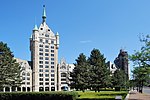USS Slater

USS Slater (DE-766) is a Cannon-class destroyer escort that served in the United States Navy and later in the Hellenic (Greek) Navy. Following service during World War II, the ship was transferred to Greece and renamed Aetos. Decommissioned in 1991, the destroyer escort was returned to the United States. USS Slater is now a museum ship on the Hudson River in Albany, New York, the only one of its kind afloat in the United States. As of 2020, fewer than 12 destroyer escorts survive, with Slater the only one in its wartime configuration. Slater was designated a National Historic Landmark on 2 March 2012.USS Slater was struck by the Hudson River touring ship Dutch Apple on 10 September 2019. A mechanical issue aboard Dutch Apple was to blame for the collision.
Excerpt from the Wikipedia article USS Slater (License: CC BY-SA 3.0, Authors, Images).USS Slater
Broadway, City of Albany
Geographical coordinates (GPS) Address Website External links Nearby Places Show on map
Geographical coordinates (GPS)
| Latitude | Longitude |
|---|---|
| N 42.642944444444 ° | E -73.749527777778 ° |
Address
USS Slater
Broadway 141
12202 City of Albany
New York, United States
Open on Google Maps







